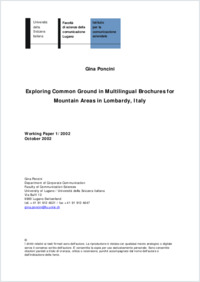Exploring common ground in multilingual brochures for mountain areas in Lombardy, Italy
- Poncini, Gina Istituto per la comunicazione aziendale (ICA), Facoltà di scienze della comunicazione, Università della Svizzera italiana, Svizzera
-
2002
26 p
English
With growing numbers of tourists representing a range of cultural backgrounds and with English taking on the role of a global language, English-language texts in multilingual and bilingual promotional materials - in this case those available in the Italian Alps - are often read by a multicultural audience. Even if one or two "English speaking cultures" are considered prime targets, the readership of English texts may in fact come from a number of cultures, especially when the material is in Italian and English only. Whatever their cultural and linguistic background, visitors or potential visitors do not share the same knowledge of the local geography, culture, traditions, specialties, and so on. Further complicating the situation is the need for choices - whether on the part of translators or members of local organizations - about whether to maintain a specialized term in the local language or "translate" it. In this context, common ground, used as a general term for those assumptions shared by interactants about common or shared knowledge, goals, wants, values, and so on, takes on an important role. This paper explores the notion of common ground, examining the presuppositions behind the use of specialized lexis in multilingual, bilingual and monolingual tourist brochures for Valtellina, a major alpine valley in Lombardy, Italy. The study investigates where common ground is presupposed in the Italian and English-language texts (e.g. the use of a proper noun that seems to represent a place-name, without any explanation as to whether it is a mountain pass, a glacier or a hotel name) and where it is not, focusing on linguistic choices that help build shared knowledge. The paper gives particular attention to selected specialized terms relating to local culture and sometimes left in Italian in the English language texts and sometimes translated, and it also examines selected instances of evaluation (Thompson and Hunston 2000). The paper discusses the linguistic choices that contribute to increasing shared knowledge about specific features and specialties of the area. It also shows that in a number of cases, a single Italian term takes on a variety of forms in the texts in English and in other languages. The paper discusses the implications of these differences in terms of building a particular image for and awareness of the area and its specialties. It discusses the issue of coordinating visitor materials, especially linguistic choices in non-Italian texts, when a number of organizations produce them. Finally, the paper considers the implications of the increasing use of the Internet to communicate aspects of the area to both visitors and local residents.
- Language
-
- English
- Classification
- Economics
- License
-
License undefined
- Open access status
- green
- Identifiers
-
- RERO DOC 5222
- ARK ark:/12658/srd1318072
- Persistent URL
- https://n2t.net/ark:/12658/srd1318072
Statistics
Document views: 205
File downloads:
- Texte intégral: 305
